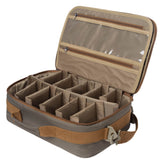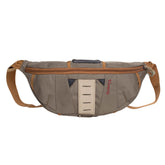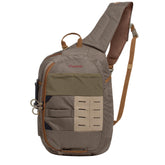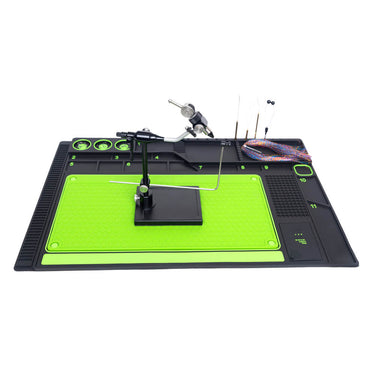Fly Fishing for Giant Trevally: An Angler’s Guide
This angler’s guide will cover everything you need to know about fly fishing for Giant Trevally including some great flies to use, techniques and destinations for giant trevally fly fishing.
Caranx Ignobilis, or Giant Trevally, is the largest of the Trevally species. It grows over 140lb and reaches lengths of well over 100cm. They prey on any living form including crabs, squid, baitfish, and even birds.
Hooking into one of these fish will be the most exciting thing you’ve ever done. The way these fish eat, the way they fight, and their sheer size make them the ultimate fly fishing species.
I spent months guiding clients on the outer atolls of Seychelles. During the countless hours I’ve spent looking for, studying, and catching these fish, I become completely fascinated. This article will share some of my thoughts.
Best Giant Trevally Flies
Contrary to belief and what the many media portrays, Giant Trevally can be extremely fussy when it comes to flies. Sure, there are instances when you’re out GT fly fishing and they’ll eat anything from a bird to a well-presented sandal. But in most cases, knowing which fly to use and how to fish it makes all the difference.
Here’s a list of some of my favorite Giant Trevally flies.
Semper
The Semper is a generic baitfish or squid imitation. It is tied using mainly natural materials. The tail is made from long chicken feathers (called Schlappen) and the body from palmered marabou. This is a great attractor to use when fly fishing GT.
Size and Colors
Sempers for Giant Trevally can be tied on 4/0 and 6/0 hook sizes. Good color combinations are:
- Tan and White
- Chartreuse and White
- Olive and Red (especially on turtle grass)
- Black and Purple
- Fishing a Semper
Present the fly between 2 and 3-rod lengths in front of the fish. Once the fly has landed, give one long strip to remove any slack and bring you in direct contact. Keep retrieving the fly with long medium pace strips. Speed up, just like a fleeing baitfish would, when the fish reacts.
Brush Fly
A brush fly can also imitate a baitfish or squid. The difference is that this fly incorporates mostly synthetic materials. This design makes it durable and easy to cast. The term “brush fly” comes from a tying technique used to build the abdomen of the fly.
The durability of the synthetic material allows the tier to attach eyes to the fly. Large, realistic eyes are a sure trigger to drive GTs crazy, making this another good fly for GT.
Size and Colors
A 6/0 or 4/0 Brush Fly works well for Giant Trevally. Synthetic material makes it possible to tie ultra-realistic flies. On the other end of the scale, synthetics come in a vast array of colors, making it possible to tie flies that produce aggressive reactions from fish. My favorite color combinations for Brush Flies are:
- Tan and White
- Red and Yellow (also known as the Flaming Lamborghini)
- Olive and White
- Chartreuse and White
- Black, red, and purple
- Fishing a Brush Fly
The Brush Fly is fished in the same way as the Semper. There is a slight difference in sink rate between the two. It is something to keep in mind so that you don’t get stuck to the bottom when the big moment arrives.
Double Barrel Popper
When the Double Barrel Popper is fished correctly, it creates a big bubble trail and massive sound. They are tied using a molded foam body and a tail made from a combination of synthetic and natural materials.
Size and Colors
When a Giant Trevally hits a popper, you need a wide gape to ensure a good hookup. Therefore, I recommend tying Double Barrel Poppers on 8/0 hooks. The best color combinations are:
- Tan and White
- Chartreuse and White
- Black and Gold
- Black and Purple
- Fishing a Double Barrel Popper
There are two scenarios where you’ll most probably use this great popper. In shallow water, you’ll most probably only cast the fly to spotted fish. The fly is cast out and retrieved very similar to the Brush Fly and Semper, as described above.
The Double Barrel Popper can also be used to pull fish up from deep reefs. This method works extremely well, especially when you have some time to kill between tides. The fly is cast out as far as possible. Long steady retrieves are made resulting in long bubble trails and big “plonk” sounds.
NYAP
The Not Your Average Popper (NYAP) was developed by James Christmas, an Alphonse Fishing Company guide based in Seychelles. It is relatively easy to cast and has great action in the water. However, the action of this fly greatly depends on the quality of the tie. If tied incorrectly, the fly skips around on the surface.
Size and Colors
I recommend using 6/0 and 8/0 variants for Giant Trevally. The best colors are:
- White and grey
- White and tan
- Plain white
Fishing a NYAP
The NYAP is best used in a sight fishing situation. It’s a great popper to use in the surf zone or on very shallow reefs and turtle grass sections. The fly is present 2 to 3-rod lengths in front of the fish. Long strips should get the fish fired up.
Clouser Minnow
As I mentioned in the How To Tie A Clouser Minnow tutorial, the Clouser Minnow is probably the best saltwater fly of all time. Giant Trevally love these flies. They are durable, simple to tie, and can be used on many different species.
The Clouser Minnow is a great fly if your other flies are being refused. In this case, step down your leader to 80lb fluorocarbon and use a 4/0 fly. Make sure that the Clouser is tied sparse and with as little flash as possible.
Size and Colors
The best sizes suited to Giant Trevally are 4/0 and 6/0 hooks. What makes the Clouser Minnow so effective is the action that the weight gives the fly. The fly also rides hook-point upward, resulting in fewer snags.
Color combinations are chosen to be as natural as possible. These include:
- Tan and White
- Olive and white
- Grey and white
Fishing a Clouser Minnow
A Clouser can be used either on deep reefs to probe around, or sight fishing in shallow clear water. On deep reefs, use a fast-sinking fly line and a heavily weighted fly. In shallow water, a floating fly line and a lightweight Clouser are the best choices.
Large Merkin
Sometimes in shallow surf zones or coral reefs, you will find Giant Trevally tailing. This sight might seem bizarre, but the fish are digging around for large crabs and crustaceans. Having a large Merkin at hand can entice a take.
Size and Colors
Merkin flies ranging from 3/0 to 6/0 will work perfectly. Try and keep them as natural as possible and match the color to the bottom where you’re fishing. Two good colors to keep in your fly box are tan and olive.
Fishing a Merkin
The placement of the cast will depend on the body language of the fish. If the fish are looking downward while tailing, the fly can be placed relatively close (within one rod length) to the fish. If they are free swimming, follow the same directions as the baitfish flies.
Best Gear for Giant Trevally Fly Fishing
Giant Trevally is notorious for being dirty fighters, trying to break you off on structure every chance they get. They can attain lengths of well over 100cm. The combination of these two factors means you need very strong and reliable gear.
In this section, we’ll look at considerations to be made when selecting every piece of gear. This will enable you to make better-informed decisions when you’re at the tackle shop, preventing frustration or a broken heart when things go wrong.
Rod
Our article on The 5 Best Saltwater Fly Rods covered the most important characteristics a dedicated saltwater fly rod has. These include:
- Being able to present the fly to the fish
- Fighting Ability
- Durability
For Giant Trevally, these 3 requirements are of utmost importance. The flies we cast at them are usually big and un-aerodynamic. The fish themselves are incredibly strong, and the places we target them are remote and hard on gear.
Reel
The reel’s time to shine comes when you hook into one of these incredible fish. Hooking into a Giant Trevally of more than 80cm will test your reel’s drag and quality. I recommend reading the Top 5 Best Saltwater Fly Reels article I wrote on selecting the best saltwater specific reel.
I’ve seen client’s reels fail while fighting big Giant Trevally. Most of these failures happened on reels that were in perfect working condition and were to no fault of the client’s technique. It highlights the importance of buying the best reel you can afford.
Good reel manufacturers are:
Abel
Shilton
Mako
Nautilus
Hatch (make sure it’s Generation 2)
Hardy
Backing
A large Giant Trevally specimen will clear the full length of a fly line within seconds. Most reels, in the 12-weight size, have a backing capacity in the region of 300 yards. This does, however, not mean that you’ll be fighting these fish at those distances.
If you allow a Giant Trevally to run more than 100 yards of your backing, you have lost the fight. The chance of landing that fish is low. In my opinion, the 300 yards of backing is there to allow you to repair your rig after losing a fly line and backing to a large fish.
I recommend using casting braid of 80lb, or more, as backing. This will provide enough strength and abrasion resistance in most situations.
Fly Line
For most applications, a weight-forward floating fly line is ideal. This line will allow you to fish in shallow water and surf conditions. It will also be possible to fish poppers and shallow Clouser Minnows over deeper reefs.
A good “dredging” line is always handy. This will enable you to get flies down deep when the fish aren’t showing any interest coming to the surface.
When preparing for a Giant Trevally trip, replace all the welded loops that come as standard on most new lines. These loops will let you down. They do not offer the strength and durability required to target these fish.
Good fly line brands for Giant Trevally include:
- Airflo
- Rio
- Cortland
Leader
A straight leader made from fluorocarbon or monofilament is required. If you’re fishing on wide white sand flats, 80lb is sufficient. In this case, ensure you loosen the drag slightly. When tackling these fish near or around structure or the surf zone, a minimum of 100lb is required.
The length of the leader should be around the same length as the rod. But, if you’re not comfortable with this length, you can shorten it slightly. It’s better to have a slightly shorter leader than not being able to present the fly to a fish.
Knots
An often-overlooked topic in my opinion. The strength, durability, reputation, and cost of all the abovementioned gear mean nothing if the knots connecting yourself to the fish are poor. Here’s are my recommended knots for every connection point on a Giant Trevally setup:
Backing to Reel
If a sizable fish runs you to the knot securing the backing to your reel, you’ve pretty much lost the fight. No knot on earth will stop that fish. I recommend using either a standard arbor or uni-knot for this application.
Backing to Fly Line
A loop-to-loop (or cat’s paw) connection secures the fly line to the backing. The loop in the backing is created by making a double Bimini twist. This ensures that the backing doesn’t cut into the fly line’s loop.
When making the Bimini twist, ensure a large enough loop is created to pass an entire fly reel though it. This loop will make it possible to quickly change a fly line if required.
Leader to Fly Line and Fly
My three favorite knots for this application are the following:
- Nail Knot (I usually only use this knot on the first rig that I use. I trust the knot, but it takes some time to tie properly on 100lb+ fluorocarbon)
- Reverse Homer-Rhode (The knot I use most often)
- Perfection Loop (If you need to tie on a fly really fast)
Giant Trevally Fly Fishing Conditions
The following two factors influence the movement and drive behind GT behavior. Knowing these will help you become better at fly fishing for GT. Be on the constant lookout for food sources and current disturbances and you’ll soon be casting in the perfect spot.
Food Source
The number one drive behind Giant Trevally’s behavior and locations where you can find them is food. Find a congregation of baitfish and chances are that these bad boys will rock up sooner or later.
Current
There are other telltales that should be kept in mind when you’re out on the water. High-speed current, rip tides, and turbulent water. These current formations are usually around a piece of structure.
Best Time for Fly Fishing for Giant Trevally
Giant Trevally behavior can vary between the areas they occur. For instance, if you’re targeting these fish on the North-Eastern Coast of South Africa, or Mozambique, very specific moon phases and times of day should be chosen. To be successful in these locations, fishing during night time is necessary.
In contrast, fishing in the crystal-clear water of Seychelles, GTs can be targeted during any time of the day. Here, the tide and water temperature play a bigger role.
Tide
My favorite moon phase to target Giant Trevally is spring tide. When the difference between low and high tides is big. This fluctuation translates into high current speeds and lower water temperature (due to less stagnant water).
The most productive phase is when the water is pushing. This means the phase from low tide to high tide.
Time of Day
If you want to increase your chances, the best time of day is at the break of dawn or during dusk. Timing the pushing tide with these times will result in the optimal Giant Trevally scenario.
Giant Trevally Fly Fishing Tips & Tricks
This section will share some tips and tricks that will help you. While guiding clients on these fish, I learned a great deal. Here are things that will help you when you’re out looking for these fish.
Be Patient
YouTube videos and fishing movies mostly show you the incredible eats and landed GTs. They do not show you the countless hours spent looking for these fish. Stick to your guns and be patient. Your shot will come.
Practice
As mentioned above, there will be times when the fishing gets hard. In some instances, having a shot or two per day is all you have. Make them count. Practice your casts and line management. Practice stripping as fast as you can. This will pay dividends, I promise you.
Do Not Trout Set
Picture this. You’re standing knee-deep in the surf zone and the guide points out a giant trevally swimming left to right. You lay down the fly 3 rod-lengths in front of the fish, perfectly. After the second-long strip, the fish goes mental. He charges the fly with his eyes and back out of the water.
As he eats you set by lifting the rod. Guides refer to this as trout set. This is a punishable offense. Don’t trout set.
Gloves
Gloves are an optional extra when casting and fighting Giant Trevally. However, when landing and handling these fish, thick gloves are absolutely necessary. The tail scutes are extremely sharp and protrude from the fish’s body.
It’s Just a Fish
I’ve seen grown men freeze and buckled knees in the sight of feeding Giant Trevally. In the months leading up to a trip, anglers unnecessarily tense themselves up to the notion of these majestic creatures. Remember, they’re just fish.
Best Destinations for Giant Trevally Fishing
Giant Trevally occurs in the Western Pacific and Indian oceans. They prefer warm, tropical water. With commercial fishing pressure and reef destruction, there aren’t many places left on earth where these fish can be targeted regularly.
The following destinations can be visited to target these fish:
Seychelles
The outer atolls of Seychelles have some of the best Giant Trevally fishing in the world. Most of these destinations offer excellent luxury accommodation and well-experienced guides.
The atolls that I recommend are:
- Cosmoledo (the GT capital of the world where most Giant Trevally are landed)
- Alphonse (including the St. Francois Atoll)
- Astove
- Farquhar
Alphonse Fishing Company runs most of the fly fishing on these remote atolls. It’s a breath-taking once in a lifetime experience. Check out my guide on Fly Fishing in Seychelles.
Mauritius
Mauritius consists of thousands of small islands. The most popular GT fishing destination is St. Brandon’s atoll. This atoll is also known for its incredibly large bonefish. FlyCastaway can be contacted for this value for money destination.
Christmas Island
Christmas Island, or Kiribati, offers excellent GT fishing. The island has been synonymous with fly fishing for many years, being a good bone fishery.
Oman
Oman is home to some of the world’s largest GTs. Most of these extremely large fish are caught on conventional tackle. Some of the specimens caught weigh over 140lb. The chance of landing such a fish on a fly is really slim, however, it is a great destination for big GTs.
No Boundaries Oman can be contacted for more information about this unique destination.
Nubian Flats
The Nubian Flats is a collection of small coralline islands in the Red Sea. Apart from offering excellent Giant Trevally fishing, it is also seen as the best Triggerfish destination in the world. I fished a couple of islands with the team of African Waters. On our best day, the group landed 43 Triggerfish.
That’s How To Fly Fish For Giant Trevally
More than anything, I hope that my passion for this fish has awakened and excited the desire to explore. Practice and study more about the topics that I have covered in this article. I am sure that if you prepare well, you’ll be able to catch a Giant Trevally.















